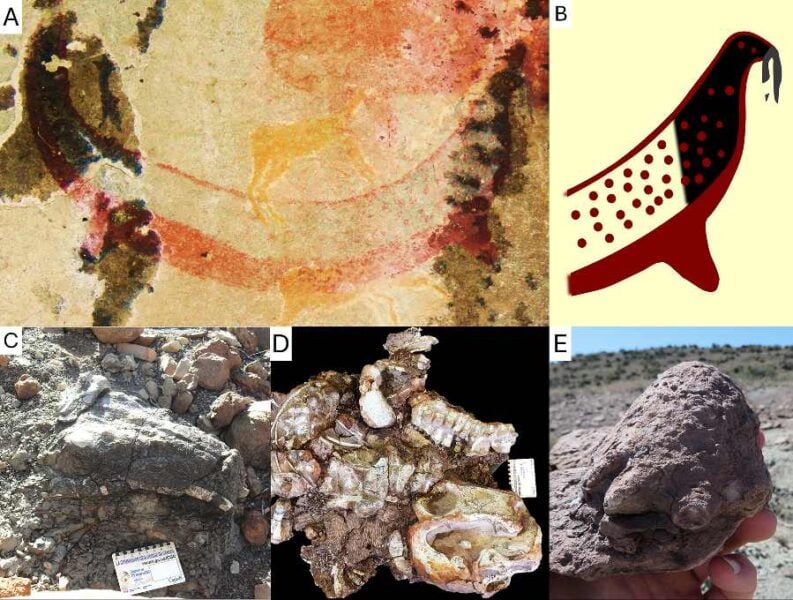Summary: A South African rock painting from the early 1800s might portray an extinct dicynodont species, suggesting indigenous knowledge of fossils predated formal scientific descriptions by at least a decade.
Estimated reading time: 5 minutes
In a fascinating intersection of art, paleontology, and indigenous knowledge, a mysterious tusked animal depicted in South African rock art may represent an ancient species preserved as fossils in the same region. This discovery, detailed in a study published September 18, 2024, in the open-access journal PLOS ONE, sheds new light on the potential paleontological awareness of the San people of South Africa.
The artwork in question is part of the Horned Serpent panel, a section of rock wall featuring paintings created by the San people between 1821 and 1835. Among the various figures depicted is a long-bodied animal with downward-turned tusks, a creature that doesn’t match any known modern species in the area.
Indigenous Paleontology: A New Perspective
Julien Benoit of the University of the Witwatersrand, Johannesburg, the study’s author, proposes an intriguing hypothesis. The San people, known for incorporating elements of their surroundings into their art, including fossils, may have drawn inspiration from extinct species for this enigmatic figure.
The Karoo Basin of South Africa, renowned for its well-preserved fossils, is home to numerous remains of tusked animals called dicynodonts. These creatures, often found eroding out of the ground, went extinct before the age of dinosaurs and long before humans appeared in Africa.
Benoit’s research suggests a compelling possibility: the tusked figure in the Horned Serpent panel might be an artistic interpretation of a dicynodont. If true, this would predate the first scientific description of these ancient animals by at least ten years.
“The painting was made in 1835 at the latest, which means this dicynodont was depicted at least ten years before the western scientific discovery and naming of the first dicynodont by Richard Owen in 1845,” Benoit explains. “This work supports that the first inhabitants of southern Africa, the San hunter-gatherers, discovered fossils, interpreted them and integrated them in their rock art and belief system.”
Bridging Ancient Art and Modern Science
The study’s findings are bolstered by San myths of large animals that once roamed the region but are now extinct. This cultural memory, combined with the artistic depiction, suggests a deep understanding of the area’s paleontological history by the indigenous population.
While archaeological evidence indicates that the San people might have collected fossils and incorporated them into their artwork, the extent of indigenous paleontological knowledge across Africa remains poorly understood. This research opens up new avenues for exploring how various human cultures around the world have integrated fossils into their cultural narratives and artistic expressions.
Implications and Future Research
The implications of this study extend beyond the realm of art history. It challenges our understanding of the development of paleontological knowledge and highlights the potential contributions of indigenous cultures to scientific discovery.
Further research into indigenous cultures and their artistic representations could provide valuable insights into early human interactions with fossils and extinct species. This interdisciplinary approach, combining archaeology, paleontology, and anthropology, may reveal a rich tapestry of ancient knowledge previously overlooked by Western science.
As we continue to unravel the mysteries of our planet’s past, it’s becoming increasingly clear that the keys to understanding may lie not just in the rocks beneath our feet, but in the art and stories passed down through generations of indigenous peoples.
Quiz
- When was the Horned Serpent panel painted?
- What extinct animal species does the study suggest might be depicted in the rock art?
- How many years before the first scientific description of dicynodonts was this painting created?
Answer Key:
- Between 1821 and 1835
- Dicynodonts
- At least ten years
Further Reading:
- PLOS ONE: A possible later stone age painting of a dicynodont (Synapsida) from the South African Karoo
- University of the Witwatersrand: Department of Paleontology
- South African Rock Art Digital Archive
Glossary of Terms:
- Dicynodont: An extinct group of mammal-like reptiles that lived during the Permian and Triassic periods.
- San people: Indigenous hunter-gatherer people of southern Africa.
- Karoo Basin: A geological formation in South Africa known for its rich fossil deposits.
- Paleontology: The study of fossils and extinct life forms.
- Geomyth: A geological feature or phenomenon explained through folklore or mythology.
- Indigenous knowledge: Traditional knowledge held by indigenous peoples, often passed down through generations.
Enjoy this story? Get our newsletter! https://scienceblog.substack.com/


